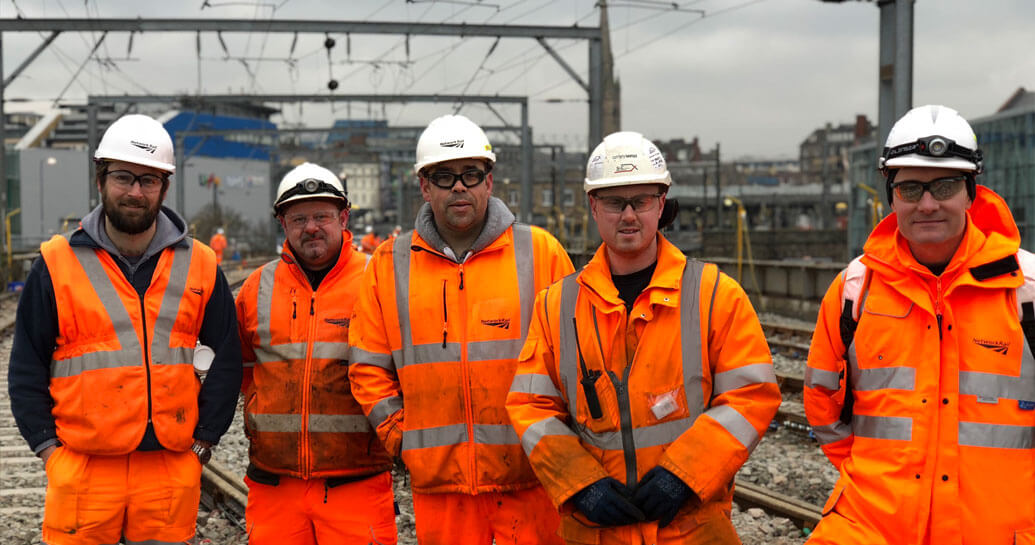Track
We’re responsible for looking after Britain’s rail network, including maintaining and renewing 20,000 miles of track.
When we talk about railway track, we mean the whole structure that trains run on, including:
- Rails – these are the lengths of steel that are welded together.
- Sleepers – these are supports for the rails.
- Switches and crossings – these are moveable sections of track that guide trains from one track to another and allow them to cross paths. They have an especially limited lifespan because trains cause wear and deformation when they travel across them.
- Sets of points – these are mechanical systems that move the switches and crossings.
How we maintain tracks
Our daily maintenance processes include:
- using tamper and ballast regulators to redistribute ballast – the stones beneath the track that give support – and compact it beneath the sleeper so that it maintains the track geometry
- carrying out profile treatment to grind away part of the rail head – the top surface of the rail that the train’s wheels run on – to leave a clean surface for a smoother ride
- monitoring our infrastructure by fitting measurement equipment to trains to identify flaws in the rail that need to be fixed.

Planned works and innovation
When a track is ‘life-expired’ and maintenance is too expensive or ineffective, we come up with solutions to refurbish or renew the track. These major projects are part of our Railway Upgrade Plan, and we carry them out at weekends or over bank holidays to minimise disruption.
Case study: Newcastle
We’ve renewed tracks in Newcastle as part of the Great North Rail Project to transform rail travel in the north of England. We completed the £8.6m track renewal project at the southern end of Newcastle station on Sunday 14 January 2018 after a nine-day blockade, replacing 19 sets of switches and crossings to make journeys more reliable.
Case study: New Cross
We renewed a junction at New Cross station, south of London Bridge on the Charing Cross to Dover Mainline, over Christmas 2016. The switches and crossings and other track equipment that make up the complex junction, which is third-rail electrified, were completely replaced to provide better, more reliable journeys on the railway – see our video below.
High-speed handbacks
Usually there’s a line speed restriction of around 50mph for a week after track renewal, to allow the ballast to settle. But after track work at Belford on the East Coast Mainline in September 2016, passenger trains ran on the track at full line speed up to 125mph thanks to engineering innovations.
New excavation techniques allow the bottom ballast to be positioned exactly, while track panels can be laid to absolute design coordinates through the use of a global positioning system (GPS), providing accuracy within 10mm. This creates a strong foundation for the track.
Find out more
World’s first ‘formation flying’ engineering trains will upgrade the railway faster and cheaper (high-speed handback on a crossing, at Sandy)
Handing back the track to train services travelling at full speed prevents delays to timetables caused by slower trains. Watch our video below about the work.
Keeping the workforce safe
We have a clear safety vision: Everyone home safe every day. One of our biggest safety risks is employees being struck by a train while maintaining the tracks. We’re addressing this risk with safety improvement projects that enable our people to plan the safe way to carry out their work, and by introducing signalling-operated train warning and train protection systems.
Seasonal maintenance
We carry out seasonal maintenance to prepare our tracks for specific weather-related issues that can cause delays to passengers.
For example, we paint certain parts of the rails white in summer to prevent them expanding and causing the rail to buckle, and attach heaters to points in winter to prevent ice forming. We also make sure our cold-weather vehicles and machines are in position at depots across Britain, fitted with special equipment to quickly de-ice tracks.
Our seasonal track treatment machines and vehicles
Working overnight
Our High Output Track Renewal System (TRS) and Ballast Cleaning System (BCS) allow us to replace track and clean ballast quickly overnight while trains continue to run safely on adjacent lines. Working overnight is essential because the railway can’t sustain the amount of weekend access we’d need to deliver such a volume of renewals.